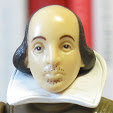 The Private Lives of Elizabeth and Essex. Dir. Michael Curtiz. Perf. Bette Davis, Errol Flynn, Vincent Price, Donald Crisp, Alan Hale, and Olivia de Havilland. 1939. DVD. Warner Home Video, 2005.
The Private Lives of Elizabeth and Essex. Dir. Michael Curtiz. Perf. Bette Davis, Errol Flynn, Vincent Price, Donald Crisp, Alan Hale, and Olivia de Havilland. 1939. DVD. Warner Home Video, 2005.I watched this film some time ago, more as a curiosity about how the times of Shakespeare were portrayed in film in the 1930s than anything else. I found it to be wonderful and terrible in equal measure. I chose the three clips below to illustrate that.
Bette Davis plays Queen Elizabeth with power and grandeur. But the Elizabeth she is asked to portray—at least in the romantic, behind-the-scenes scenes with Essex—is sappily and ridiculously (not to mention unhistorically) romantic. Errol Flynn is good as Essex—he's lovely at flying into rages. But the romantic side of him is sentimental rather than swashbuckling.
The Queen's entrance is nicely done: though it's not meticulous about period furnishings, costumes, or attitudes, it provides a sense of grandeur to the royal personage.
The film also provides an interesting twist on the story of Queen Elizabeth's reaction to a performance of Richard II. In 1601, Shakespeare's company was paid to put on a production of Richard II the day before a failed insurrection. The play addresses the successful deposition of an unpopular monarch, and the theory is that the leaders of the insurrection (the Earl of Essex and his crowd) thought that the play would rally the people to their cause—or, at least, give them courage to go through with a dangerous and deadly—and, for Essex and many others, fatal—operation. Afterwards, in extreme pique, Her Majesty purportedly said, "I am Richard—know ye not that?"
In this clip. Her Majesty is much more laid-back about the situation, chiding Lord Burghley, one of her advisors, for censoring "Master Shakespeare and his players without consulting me."
Finally, yes, that is Vincent Price, lurking in the background, playing Sir Walter Raleigh, looking guilty at having intercepted the letters Elizabeth and Essex wrote each other during Essex's Irish campaign. I knew you'd recognize him!
Links: The Film at IMDB.









No comments:
Post a Comment